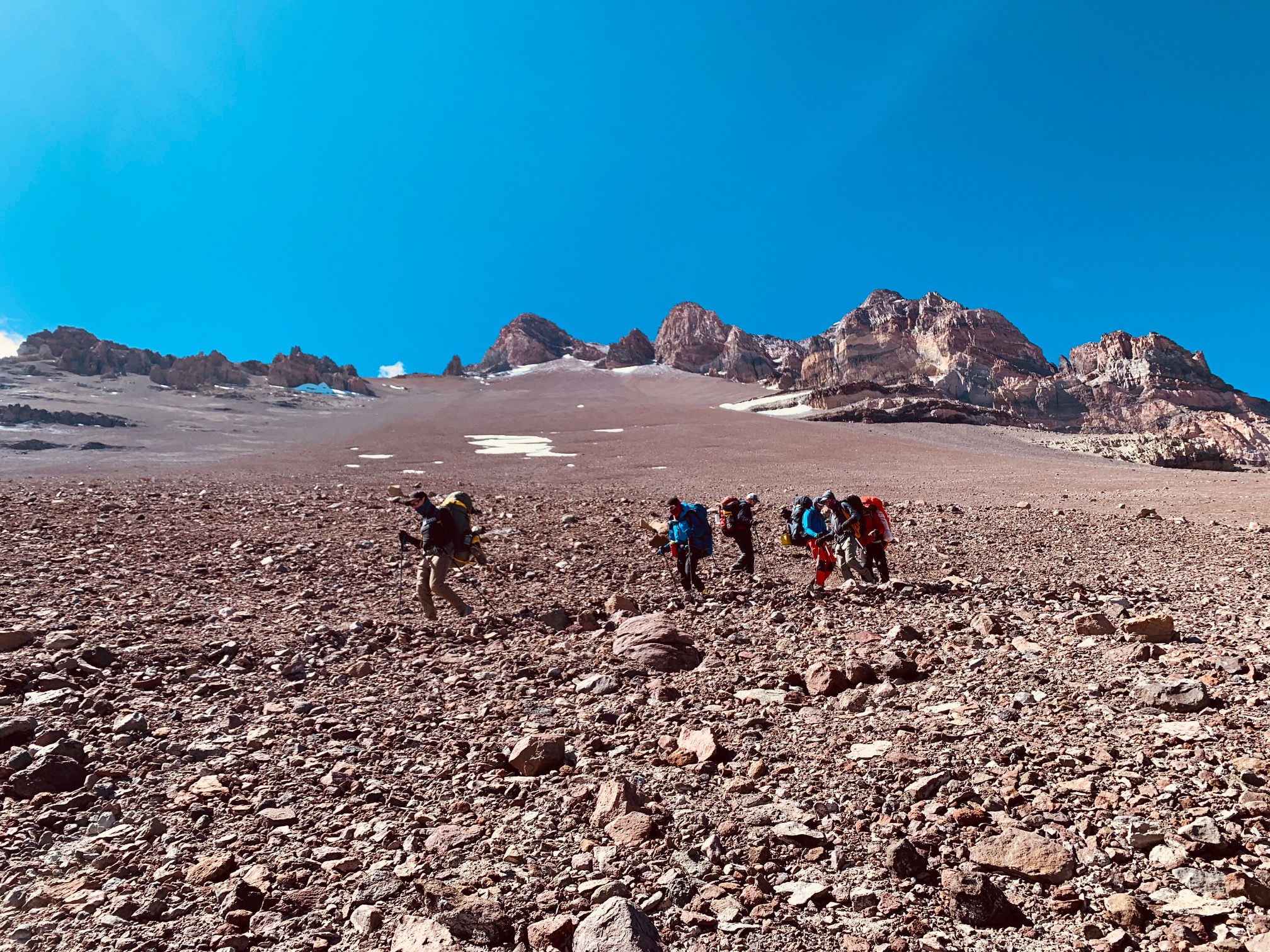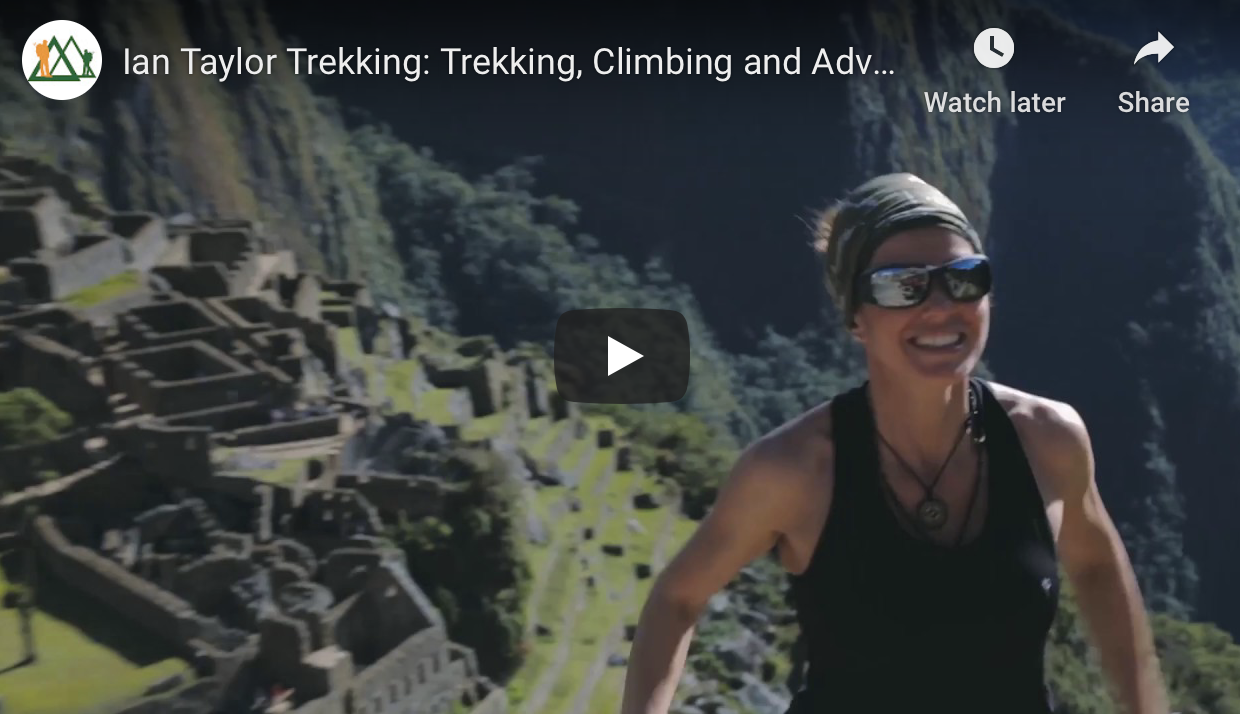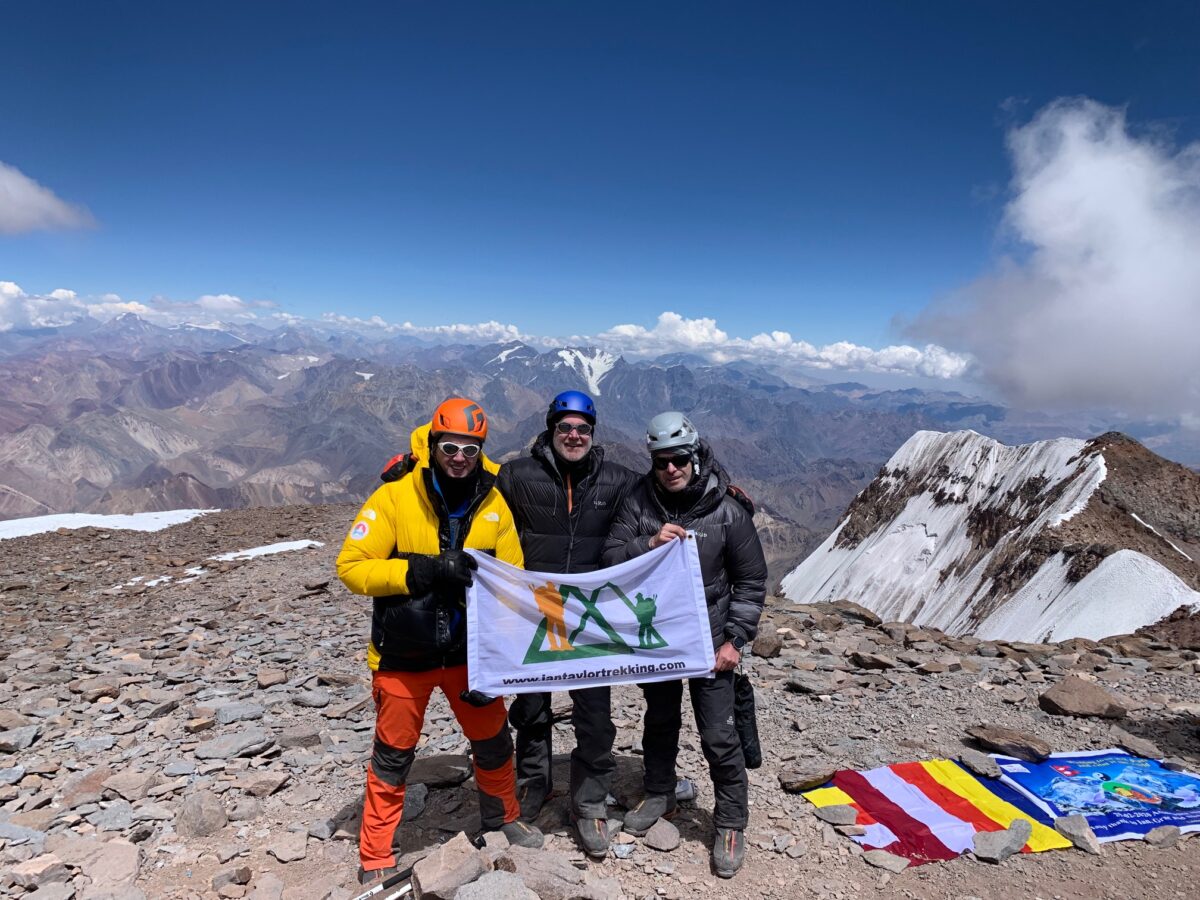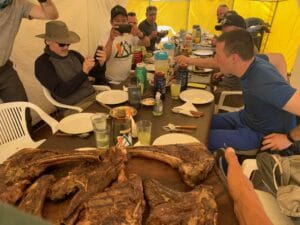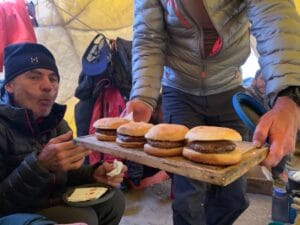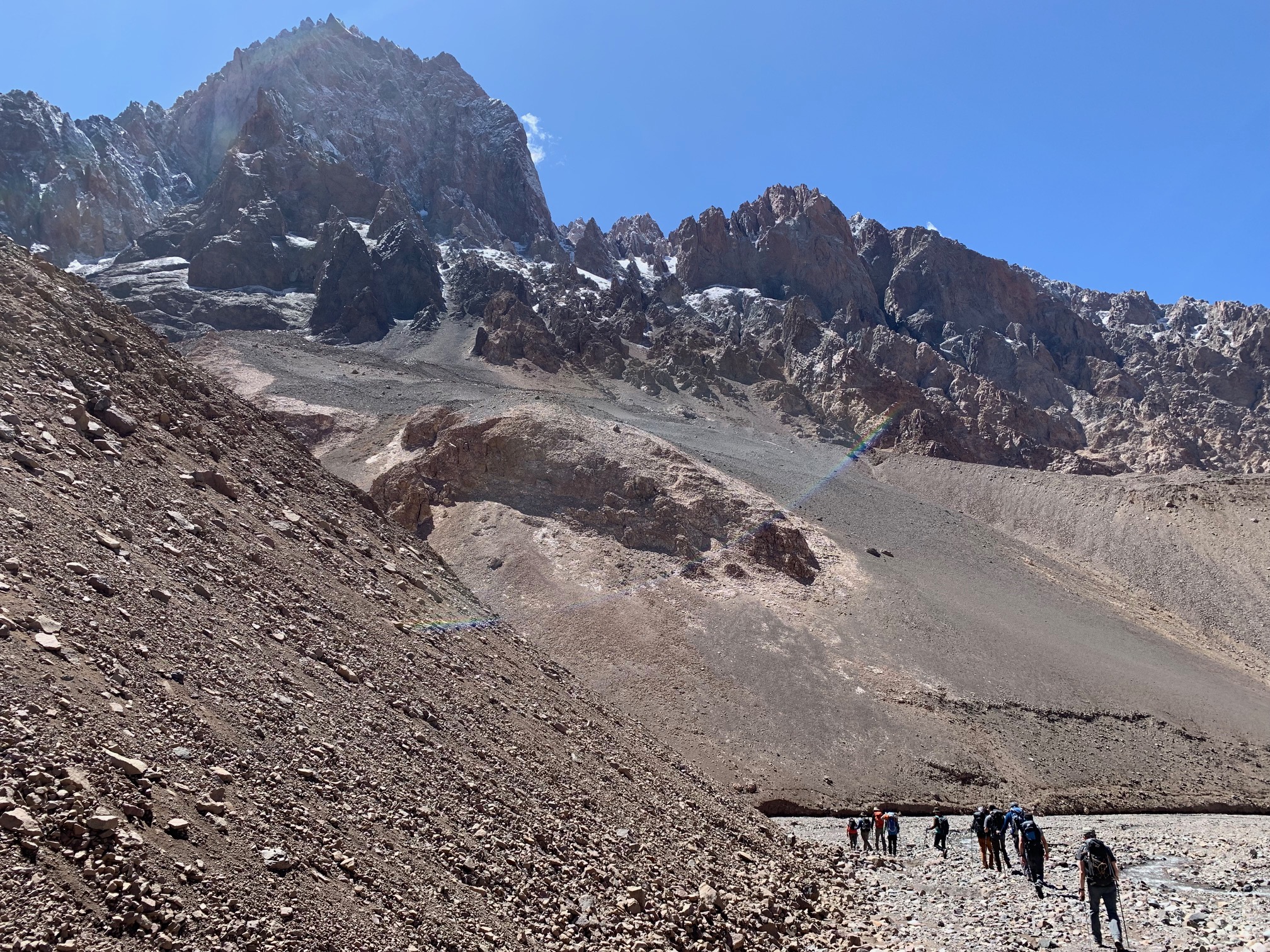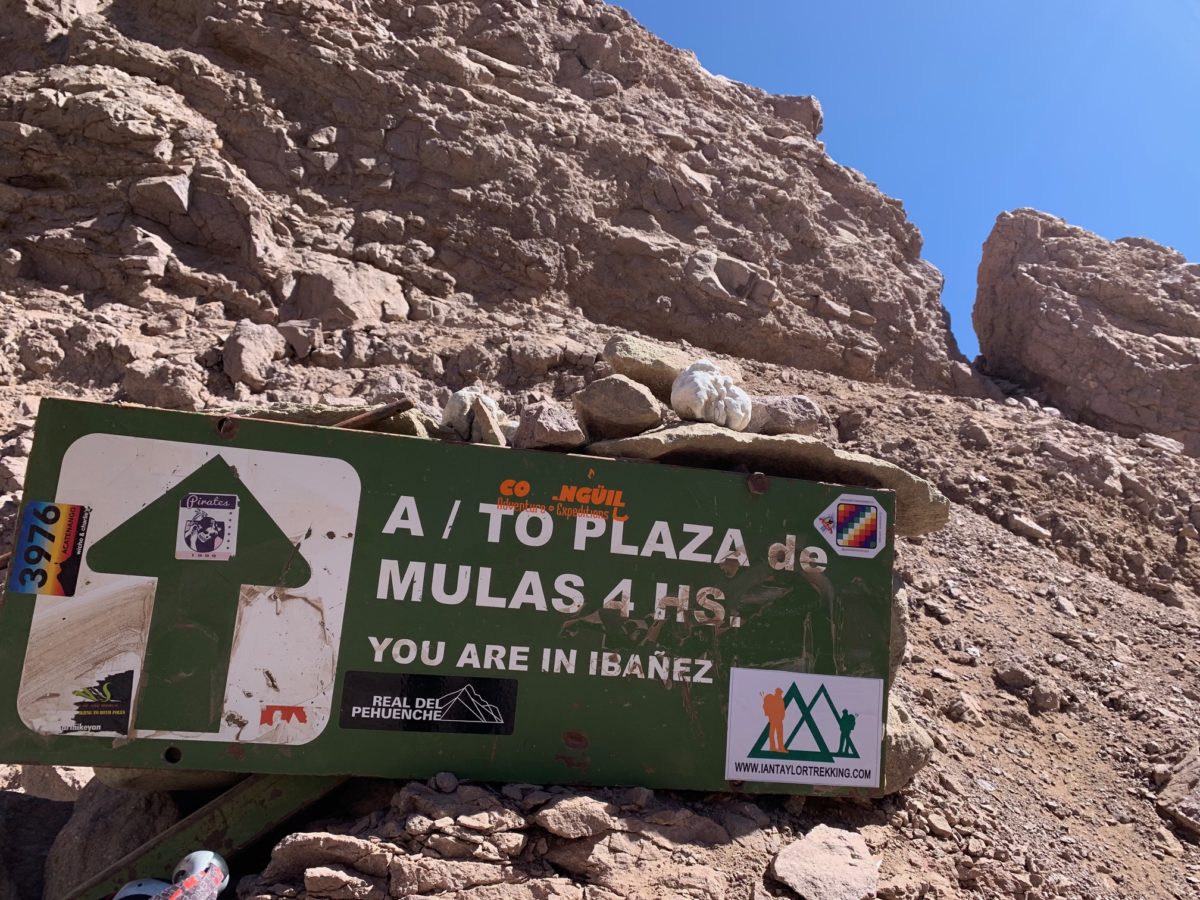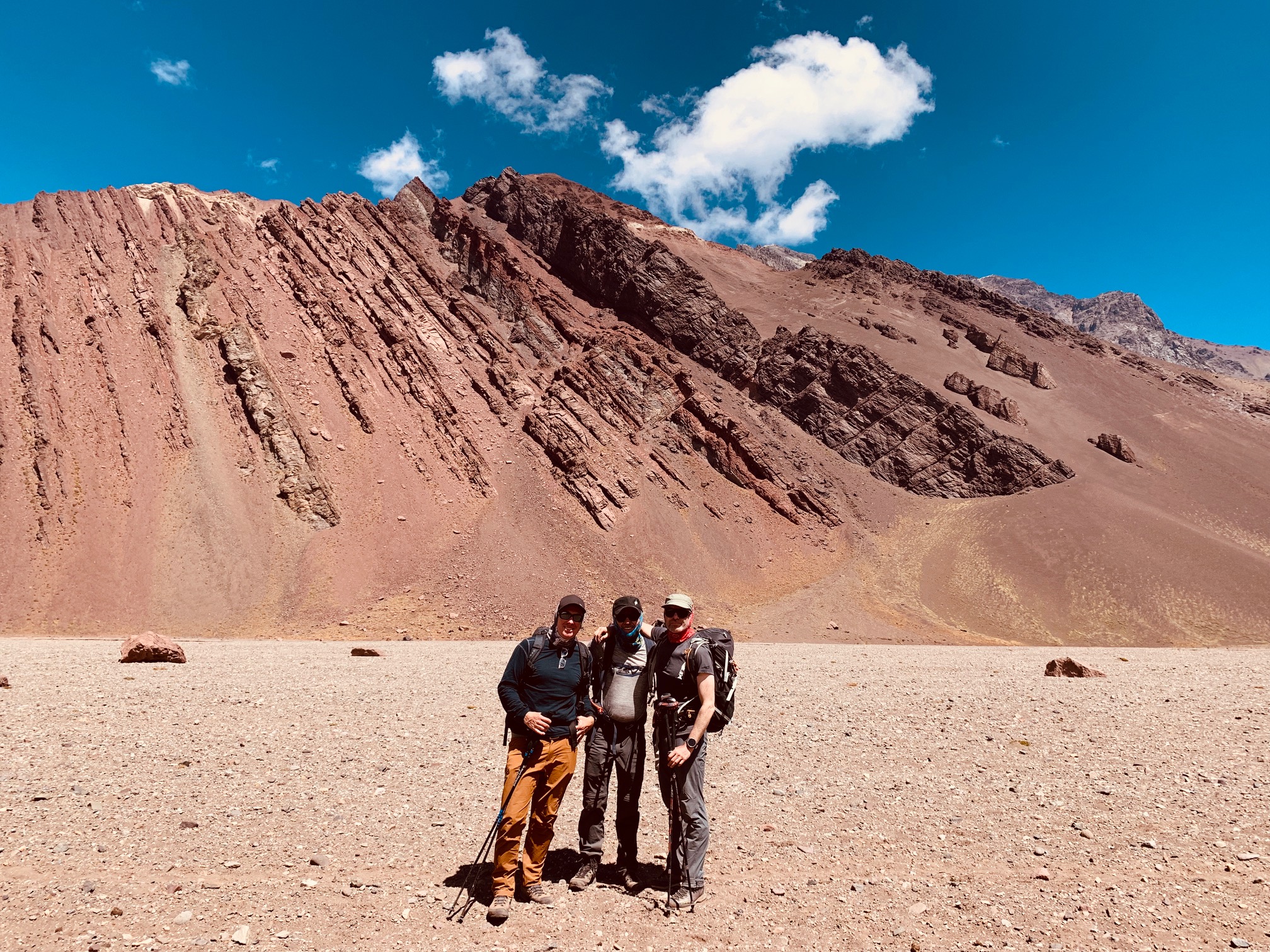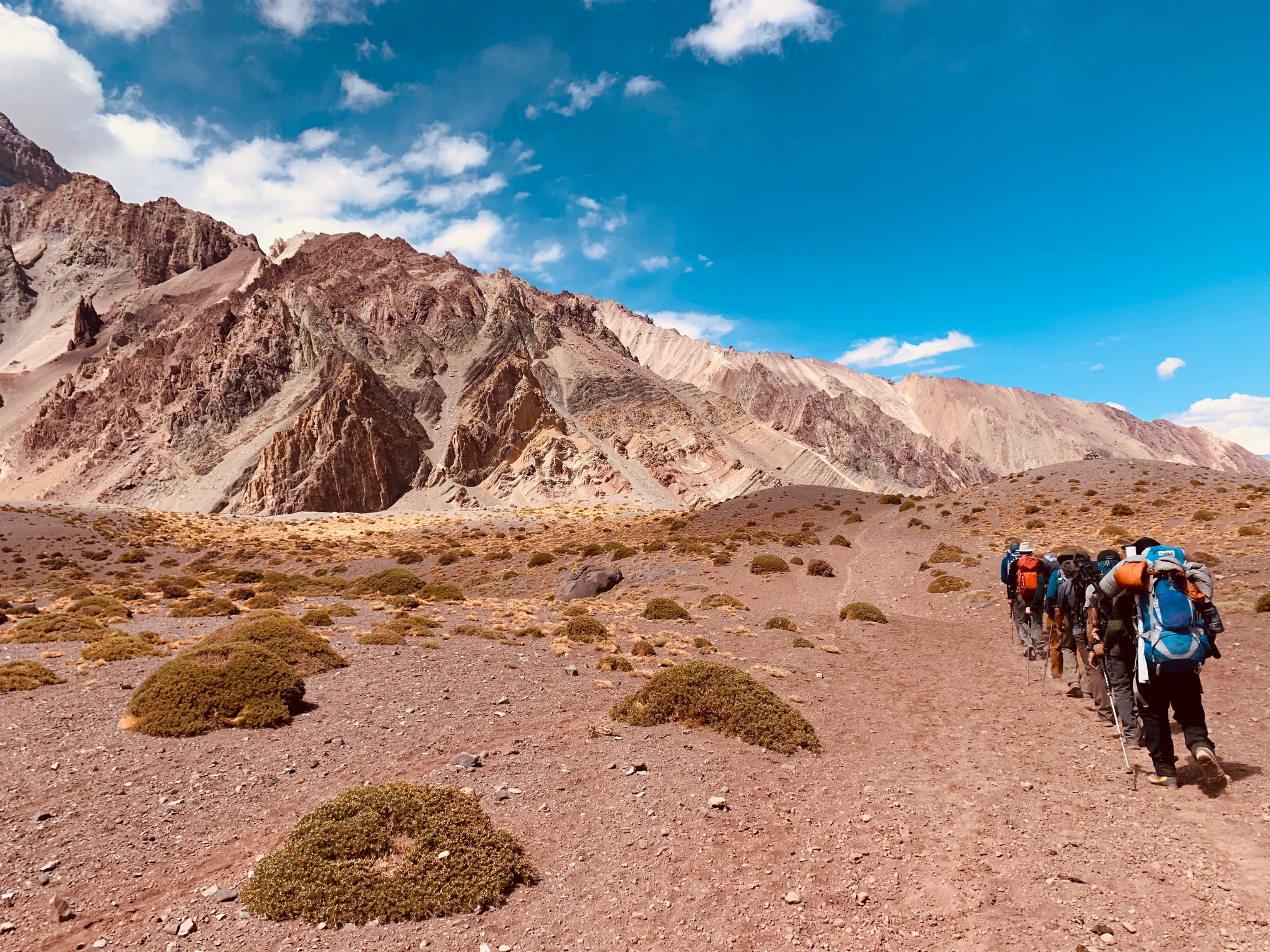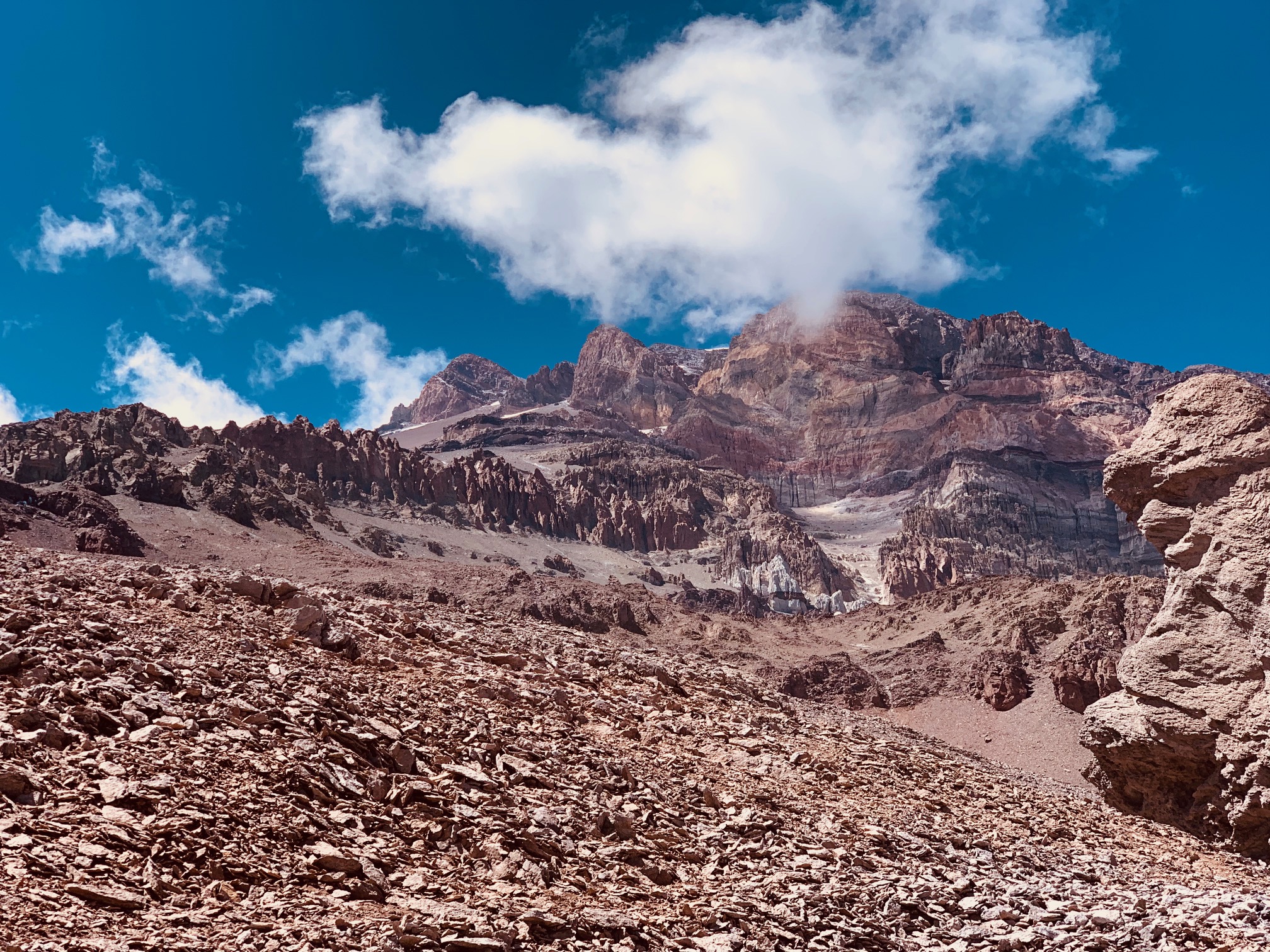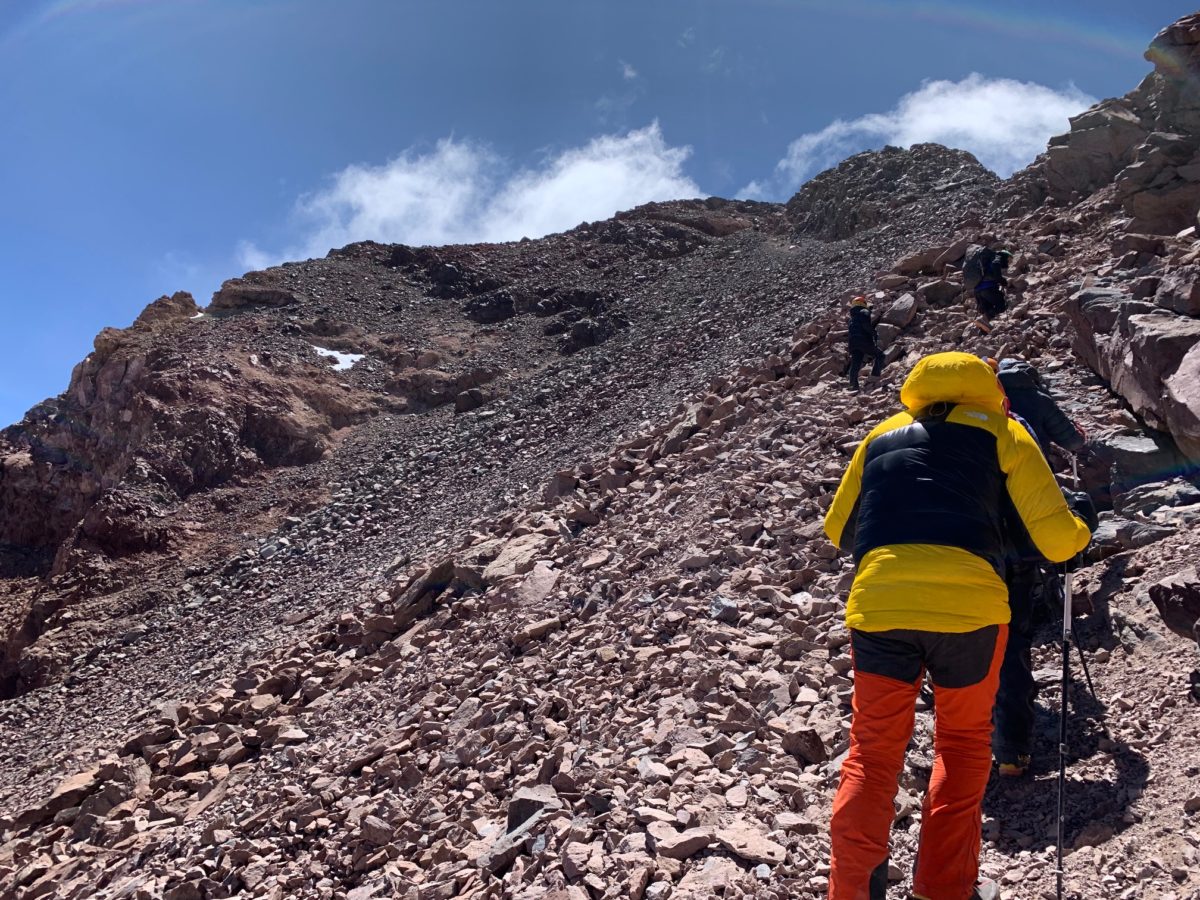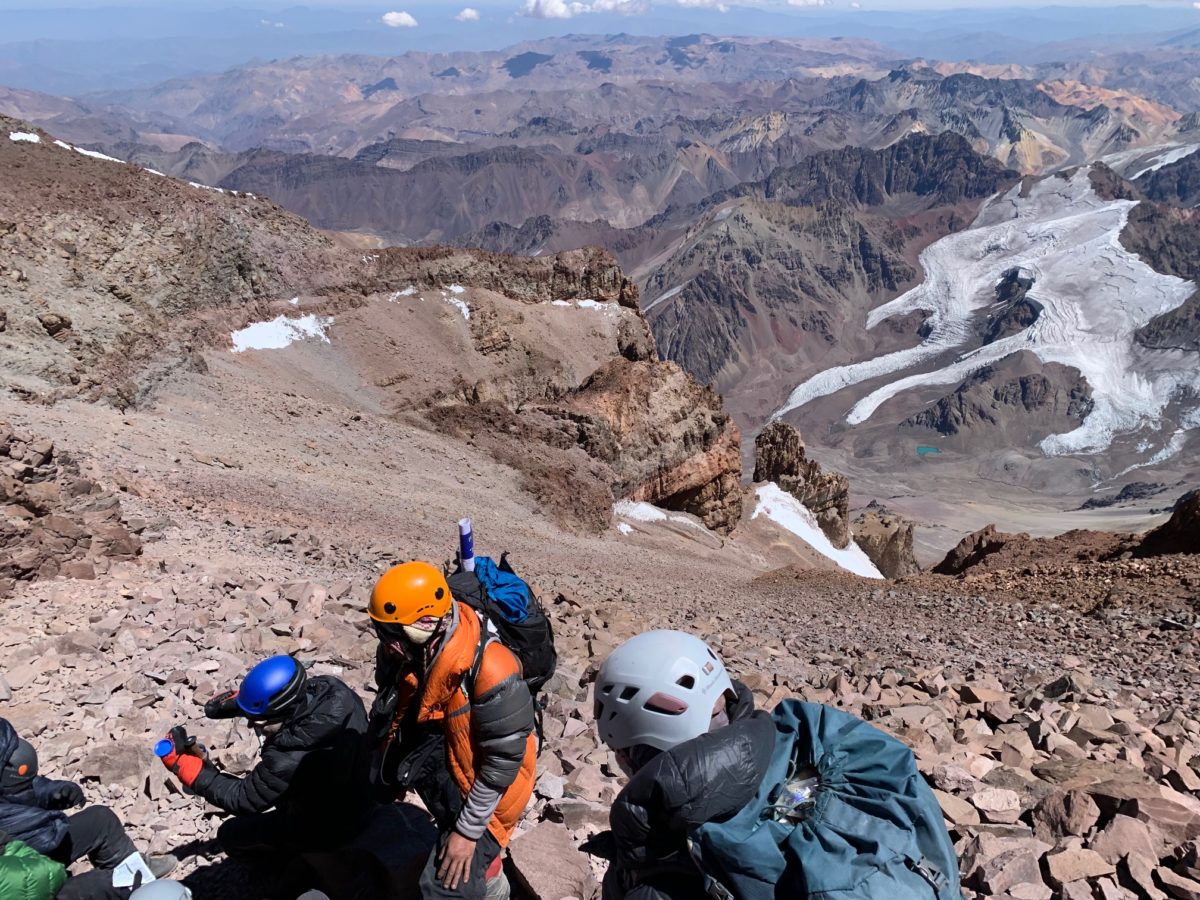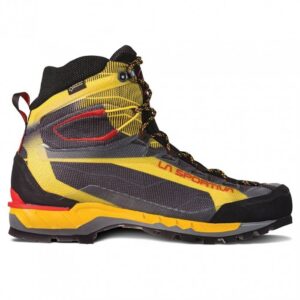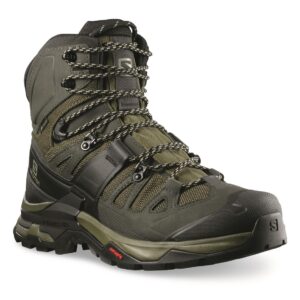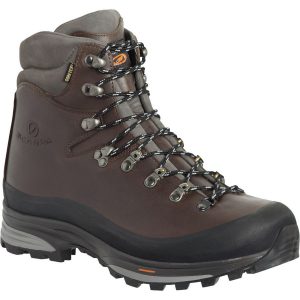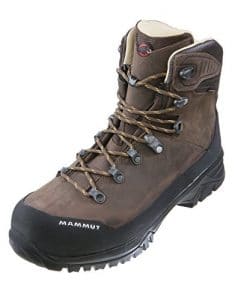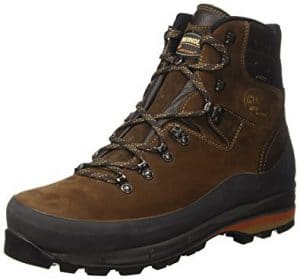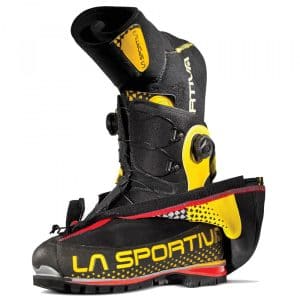Aconcagua The Normal Route
Tips and Advice
1). Have Previous Altitude Experience
Having previous altitude experience is imperative when planning an attempt on Aconcagua. We believe that everyone should have 6,000m/ 19,685 feet experience, before attempting a peak like Aconcagua. There are a number of high altitude peaks you need to consider before even thinking about climbing Aconcagua. You need to be as self-sufficient as possible and be used to carrying your own gear, on long, multiday hikes. If you are not hiring a porter to carry some or all of your gear, we recommend that you have experience with hiking at altitude with weight before taking on this challenge. We are available to talk with you directly to make sure that Aconcagua is the right choice for you.
2). Do Not Underestimate Your Training
Can you carry a 20kg/ 44lbs pack for 4 to 6 hours at sea level? Do not underestimate the training needed to be safe and successful climbing Aconcagua. Follow a regular training regime. If you are not using porters high on the mountain, then you should be comfortable carrying a 20kg/ 44lb pack for 1,000m/ 3,000 feet in 5 hours, several days in a row. We highly recommend finding a hypoxic training facility and using a machine 3 weeks before the trip. Creating red blood cells is key for success on Aconcagua.
However, if you want to carry less weight every day be sure to book porters in advance. We can not emphasize how important your physical preparation is for this challenging trip at high and extreme altitude. We have climbed Aconcagua many times and always happy to help you develop the training plan you need.
3). Acclimatization is Very Important
Make sure you have adequate acclimatization built into your trip. We have additional days available on the mountain, to give you the best chance at safely reaching the summit. Make sure that you choose an itinerary that gives your body the necessary time to acclimatize lower down on the mountain, at the critical acclimatization points. Check out our itinerary on the Vacas valley route, which in our opinion, is the best route to climb Aconcagua. Acclimatization is a critical component for safety and success on any high and extreme altitude expedition.
4). Bring Lightweight Equipment
On any Aconcagua expedition, you have to make numerous ascents up and down the mountain. One reason for this is to help the body adjust to the lower levels of oxygen. You also have to carry team equipment, along with your own personal gear. Make sure you have all items on the gear list and know how to use them. Having lightweight clothing and equipment will make a difference in how much weight you are carrying. Also, practice using your gear and equipment and make sure it fits comfortably. Having lightweight equipment and clothing means you will have to carry less weight up and down the mountain. Having prepared your gear and using each piece before the trip, helps you become mentally prepared.
5). Get a VO2 Max Test
Schedule a physical with your doctor to make sure you are in good health before you start training. You should then consider getting a VO2 MAX test or fitness test. The results should indicate your current level of fitness and provide a road map for the way ahead. Use the results to develop a proper training plan, so you are not guessing how your fitness is developing. You need to know at what heart rate your body produces lactic acid in your muscles. Knowing your lactic threshold helps you develop a training plan best suited to your needs. Training in the right heart rate zone and building the right training is important for your safety and success.
6). Understand Altitude Sickness
If you have been on a number of altitude expeditions with us you will know all about altitude related issues and problems. You should be up to date with statistics. Did you know around 30% of people make it to the summit of Aconcagua. Read and understand the principles of acclimatization and altitude illness. We have personally developed our itinerary on the Vacas Valley Traverse to give you the best chance at success. By picking the best itinerary with more acclimatization, you give yourself a safer journey into extreme altitude. You also need an itinerary with built in contingency days for bad weather. Aconcagua is notorious for harsh weather conditions, so you want to make sure that you have extra days to summit if the weather is not suitable.
7). You Should Consider Taking Diamox
If you are taking prescription drugs, make sure you bring a sufficient supply to last more than the length of your trip. We highly recommend taking Diamox for the duration of the trip. Our high altitude specialist doctor recommends 125mg in the morning and 125mg in the afternoon. Make sure your Diamox is in tablet form. You will also need to bring a number of antibiotics. There are alternatives to taking Diamox and you most certainly should bring ibuprofen on this trip.
8). Be Upfront With Your Medical History
Make sure your guides and trekking staff are informed of any previous conditions or medical situation you may have. Don’t keep any issues to yourself, altitude sickness can kill. We implement a slow pace for all trekking and acclimatization days on the trip, however, you can still have altitude related issues. Make sure that your guide knows your medical history.
9). Take Your Time in the Early Stage of the Trip
The pace of your trip is critical to recovery each day. Moving too quickly at altitude often leads to altitude illness and does not aid in your recovery. Fatigue is not your friend on a multi day trekking expedition. Good recovery is critical for a safe and successful trip. Don’t let your climb on Aconcagua be miss-managed by the guides who have no understanding of pacing or hydration in low oxygen environments. A slow pace and slow movement to high and extreme altitude is very important.
10). Hydration, Hydration, Hydration
One of the most important tips we will give you is to make hydration a priority. Hydration in the dry desert of Aconcagua is extremely important. When you wake up you need to drink 1 liter of water before breakfast. You need to drink 2 liters before lunch and another 1 to 2 liters in the early afternoon. Using a water bladder system is ideal because you can then drip feed water into your body on a regular basis. This will be used on the trek in and lower on the mountain, however during the summit attempt it can not be used as it will freeze. Forcing water in, is not a good idea as you will just pee it out. You will need hyper hydration sachets, multi-vitamins and electrolytes while on the trip.
11). Separate all Your Gear into Dry Packs
Manage your gear well and keep all items separated in dry packs. Alternatively, you can keep your clothes in plastic bags. While you are on the mountain you will need to manage your gear in the tent correctly. Having a good tent routine is very important, keeping separate bags for gear is very useful. The dry bags are useful to keep your gear organized when you do gear drops up the mountain.
12). Make Sure you Eat as Much as Possible
We always have quality food on our trips and this is critical to your expedition. Sometimes at altitude, your appetite can dwindle, but you need to try and finish every meal. It will give you the strength and energy for each day on the trip. You do not want to over pack snacks as you have to carry everything up and down the mountain. You should have some recovery and protein bars in your duffel bag, which is carried by mules up to Base Camp. After that you will want to limit the amounts you carry on the mountain. Lightweight is best and snacks can be heavy.
13). Bring a Lightweight Air Mattress and Sleeping Bag
Remember above Aconcagua Base Camp, you will have to carry all your gear up the mountain. Make sure all your gear is as light as possible. You need to have a lightweight air mattress and warm sleeping bag. We recommend a Marmot Col -20F sleeping bag or similar on Aconcagua. You spend a lot of time in the your tent on the mountain, so you need to be comfortable throughout the whole trip. Sleep is a key ingredient to acclimatization and essential for success. Also, make sure that you have tested out your sleeping pad and bag out in the elements, so that you are comfortable with the set-up.
14). Work With your Teammates
Working as a unit and team is important in achieving the groups goals. Communicate with the guides if you are having problems. They can only help if they know that you are struggling. Aconcagua requires you to be a team player and maintaining a positive mental attitude at all times throughout the expedition. Encourage others and others will encourage you. We are much stronger as a group, not as individuals.
15). Bring Multi-Vitamins
We recommend taking multi-vitamins on a daily basis before and during the trip. These can either be the type that we dissolve in our water or as a tablet to take daily. You need to consider a range of supplements to maintain a strong immune system. Aconcagua is a dry high desert, so bring hydration tablets for your water to take daily. If you sign up with Ian Taylor Trekking for your Aconcagua expedition, we will send you a trip Dossier, that includes a complete kit-list for the trip.
16). Only Bring Essentials
Have a small medical kit that is easy accessible while climbing. This medical kit should have Ibuprofen, blisters plasters, tape, sunscreen, lip protection, medication, plasters and personal items. Also, make sure you have your personal medication you take with you at all times. You need to streamline your medical kit, in the same way you would on any trekking and mountaineering trips. Bring lightweight clothing and lightweight camping utensils.
17). Come With the Correct Mental Training
Having the experience of sleeping in a tent, in harsh weather conditions, will be essential in your preparations. Also carry a weighted backpack in your training, in order to be physically ready for the summit. Mentally prepared for your Aconcagua experience, for example, pushing the limit in your training sessions helps. Additionally, the more comfortable you are in a mountain environment, the more mentally prepared you will be. Staying positive with a good mental attitude on the mountain, is important for you and the people around you. Aconcagua is a mental and physical challenge. Staying positive in the face of harsh, challenging conditions is needed to be successful. Mental preparation starts at home in the hard training you do before the climb.
18). Expect Harsh Weather Conditions
Be ready to cope with diverse weather conditions. You may experience drastic changes in the weather from warm/dry conditions to freezing and windy weather. Some days you may have temperatures lower down on the trek that are 18C (65F) and sunny to -18C (0F) in the tent at camp 3 at 6,000m/ 19,685 feet. Likewise, on the summit night, you may experience temperatures as cold as -30C (-22F). High winds are usually the biggest challenge on Aconcagua, similarly freezing temperatures can cause you pain and discomfort. Understanding that some factors are beyond your control, and weather being a big one of these. Focus on the elements of the trip you can control, for instance you can come with the right attitude, gear and physical preparation.
19). Hit the Wall in Your Training
Know your limit on any mountain. One of the ways to achieve this is to hit the wall in your training at home. Remember your safety and the safety of others should be your number one concern on the mountain. Make sure that you have pushed yourself hard in your training and have prepared correctly before stepping foot onto the mountain. While you are on Aconcagua, don’t push yourself to the point of putting your life or the life of others in danger.
20). Respect Your Team and the Mountain
Respect your team and other climbers. You are climbing as a part of a team and therefore, you have to be aware that timelines have to be kept and differences have to be accepted. An expedition can be a multicultural experience with people joining our trips from all over the world. That means different cultural backgrounds with different religious ideals or philosophies. Everyone in your expedition is struggling to reach the same goal, so respect the team. If you see your team member struggling on any given day, be there to help them. It could be you the next day that needs the extra support! Team work and relaxed attitude will be valuable assets on a trip like this, finally respect the mountain and extreme altitude.
1). Highly Experienced Guides
Our mountain guides are qualified professionals of the Argentinean Association of Mountain Guides and school of High Mountain and Trekking Guides. The last qualification is a result of 3 years of Studying. We believe that to succeed in our expeditions, professionals with experience and the ability to offer security should guide our teams. Their equipment includes: VHF radio, Satellite phone, a first aid kit, complete with the appropriate drugs for altitude sickness, ropes, an altimeter, and professional clothing and equipment. All will provide security and comfort.
All of our guides hold professional mountaineering qualifications and wilderness First Aid Certificates. They are able to get you the help you need in case of an emergency. Also, our guides have continuous access to Base Camp and Head Office. We want to make sure all of our teams have the best chance at safely reaching their goal. With more guides with your team, they will be able to more efficiently manage your safety on the mountain and also give you a better experience along the way. Read some REVIEWS from our trips.
2). Expert Training Advice
We offer personal service with training advice for our clients, 5 days a week. A lot of people underestimate the physical preparation needed for Mount Elbrus. If you decide to climb on the northern side there is minimal safety in place, no helicopters and no snow cats. Therefore, we use the southern side of Mount Elbrus for our final ascent. This offers you better safety and success.
We want to make sure that you have the best information on how to complete this adventure safely and successfully. There are some long 8+ hour days, with over 1,000m/ 3,280 feet of up and down hills on steep terrain while on the trail and mountain. We have professional training advice available to you 5 days a week. All you have to do is e-mail us and we can schedule a call. Read more. We also provide you with a 40 page Aconcagua Dossier with a lot more information on how to prepare for the trip.
3). Climb with an Everest Summiteer
Why not sign up to one of the trips that Ian personally leads. You can climb Aconcagua with someone who not only has reached the top of Mount Everest! but who has been on 7 Aconcagua Expeditions. Ian usually leads one Aconcagua trip every other year with 14 spaces open. You will need to book far enough in advance for these trips. Sign up and get access to Ian today.
4). 20 Years of High Altitude Experience at Your Service
We have years of experience managing teams on the ground in Argentina and around the world. Ian has led over 150 expeditions above 17,000 feet. Our head guides have been at the forefront of setting the standard on Aconcagua for the last 20 years. Our team is well connected on the ground with access to all the key organization and authorities. All our other guides are highly qualified in a range of mountaineering disciplines. We always have 1 guide for every 3/4 clients high on the mountain.
5). Quality Hotel, Service, Tents, Food and Equipment
In Mendoza we use the Diplomat Hotel. This hotel is centrally located. On the mountain we mostly use North Face VE 25 tents or Mountain Hard wear tents. These tents are tried and tested at high and extreme altitude. They have plenty of space for two people and the highest quality tents for mountain travel. We do have the option for a single tent for an additional fee for the trek in and Base Camp portion of this trip. For Safety reasons we like to have two people to a tent high on the mountain.
We have chefs in both Base Camps serving high quality food daily. There is access to showers, Wi-Fi, fruit, tea’s and snacks throughout the day. You can also charge phones and batteries in our dining tent.
6). Our Itinerary
Feel free to review our Aconcagua Itinerary and we are happy to explain why we prefer the Vacas Valley route over the boring normal route for climbing Aconcagua. The Vacas valley offers a more interesting trek into Aconcagua. There are less people on this side of the mountain and traversing the mountain is far more interesting for our groups. Camp 1 and Camp 2 are in more beautiful setting than anything on the normal route up Aconcagua. It is more expensive but worth it to have less people or more interested scenery.
7). All Inclusive Packages
We will pick you up from the airport and bring you to the Diplomat Hotel in Mendoza. Our staff will collect your permit fee and process the permit so you do not have to go and wait at the permitting office. All transport will be in high quality private vehicles. All of our trips include four nights when you can make a summit attempt. This is important to give the team the best chance at the summit.
On the mountain we service two course meals each day on the mountain. Therefore, you do not have to worry about bringing extra food. We have professional chefs in Base Camp on either side of the mountain. We can guarantee quality food throughout the trek because we fury fresh food into our campsites and Base Camps.
9). Small Group Sizes
We only work with small group sizes. The maximum number of people per team will be 12 people. Some of our groups are even less people with only 6 or 8 team members. We also run private groups to Aconcagua. This will therefore give you are more personalized experience on Aconcagua. We recommend this trip in the shoulder season as there can be too many people on the mountain.
We believe the journey is far more valuable than the destination. Building a team throughout our program so you can acclimatize well and experience the best of this region of the world. Our guides will monitor your heart rate and oxygen saturation morning and night to make sure you are acclimatizing correctly to the lack of oxygen.
10). Work with the Experts
Climbing Aconcagua is no easy task and you need the team, support and experience with you and behind you prior to your trip and on the mountain. Contact us for more information on our unique itinerary that we have tried and tested over many years.
1). Acclimatization and Spare Days
Every expedition to high and extreme altitude needs specific acclimatization. Aconcagua also requires at least four days when you can make a summit attempt. On my last expedition we had to make a summit attempt a day early. The weather forecast was showing four days of bad weather during our planned summit attempt.
The first time I went to Aconcagua we were on the summit on day twelve. It was way to fast and it was a terrible experience. The guide was moving too fast and made for a terrible experience and lessons learned.
You need to take your time for your body to adjust to the low levels of oxygen. Acclimatization is everything on Aconcagua. As you go higher, the barometric pressure decreases, although the air still contains 21% oxygen, every breath contains less molecules of oxygen.
2). Physical Preparation
Aconcagua requires excellent physical preparation. We are available to help our clients understand the physical demands on climbing at high and extreme altitude. Learn more and get in touch with us directly as we can help you develop a training plans that will work for you. From experience the best way to prepare will be hiking up and down hills building from 500m/ 1,640 feet to 1,500m/ 5,000 feet over the course of months.
Daily training sessions our a must in supporting your longer weekly training session or hike. You should consider using the Stairmaster and develop a weight training plan. Strength building and endurance will be your core training. The Stairmaster carrying weight, building up to being comfortable carrying 20kg/ 44lbs will be important. You will need to carry different weights in different training sessions and we can help you develop this plan.
3). Weather
The weather on Aconcagua is unpredictable and challenging at the best of times. The success rate on Aconcagua is around 30% of people make the summit. There are many factors like lack of physical preparation, acclimatization but the weather, specifically high wind are the reason the success rate is so low.
Aconcagua is only 80 miles from the Pacific ocean, leading to extremely high winds and storms, similar to Denali in Alaska. The wind chills can drop well below zero in Fahrenheit in the better climbing months. This is why you need more contingency days for your expedition.
4). Prior Altitude Experience
Having specific conditioning and altitude experience from years of high altitude trips will only help you on Aconcagua. If you are thinking of climbing Aconcagua we recommend going on a number of high altitude trips prior to signing up to an Aconcagua trip.
Learning more about how you respond to low oxygen environments is critical for your safety on this mountain. You should consider, Everest Base Camp Trek, Kilimanjaro, Mount Elbrus, Island or Mera Peak. Everyone acclimatizes differently and it is important for you to understand how your body reacts in low oxygen environments. The more experience you have the better prepared you will be.
Depending on the service you are looking for, you will find a wide range of food options on an Aconcagua Expedition. We only run quality trips with professional service and quality food. Aconcagua can be a challenging place, so some home comforts are important on our trips.
Quality Food
Your choice, but we like to have access to better food and service for our Aconcagua Expeditions. For us this is so important for your enjoyment and comfort. Quality food also adds to a successful mountain experience. We have helped hundreds of people reach their goal and they pick Ian Taylor Trekking for a quality run trip. Read some reviews from our trips.
Picking the Right Trekking Group
Ian Taylor Trekking work with professional local guides to offer the highest level of service on Aconcagua. We have control over the service we offer on the ground and have developed the service over a number of years. We have extra days 3/4 for summit attempts and we provide the highest level of equipment and food throughout the expedition.
Information on our Menu
While you are in Aconcagua Base Camp you will be served 3 course meals. We vary the menu with steak, chicken, pasta and vegetables. We serve a balanced diet plan and always thinking about the food served for the level of activity on a given day. When we are taking lunch higher on the mountain we give you a packed lunch with cereals, cookies and sandwich’s. If you like Pies, hamburgers, pasta carbonara, Sausage and mashed potato’s we have it. Quesadillas with cheese and ham, ramen with noodles and rice and vegetables. Finally, we don’t cut corners and give you the best service and experience on your journey to the summit of Aconcagua.
 Quality Run Treks Through Experience
Quality Run Treks Through Experience
Ian Taylor Trekking have been working on Aconcagua for 12 years now, building the best experience and service possible with local partners. We want you can experience the journey of a lifetime and enjoy every day of your trip. If you want a personal training plan, the best acclimatization and hang out with our amazing staff and team then get in touch today. Sign up and start getting prepared, we have years of Aconcagua experience built into every trip. We are happy to share our knowledge to help you reach the highest point in South America.
Safety on The Trail
Aconcagua can be a very busy place. Learn more. This is why we like to run trips at very specific time. We recommend early December late January and February for climbing Aconcagua. Designing our itinerary, our primary goal is to keep everyone safe. We want people to give themselves the best chance at successfully reaching the summit and having more summit days available in case of bad weather. We have 4 guides for every group of 10 climbers high on the mountain. This will give you a safer and more enjoyable experience on the trail.
Trek with Ian Taylor
We run about 4 planned group trips to Aconcagua per year. Ian usually leads an Aconcagua trip every two years and booking well in advance is highly recommended. Ian has climbed Everest and Aconcagua 7 times to date. CLICK HERE and check out our up coming trips. Ian is always happy to get on a call and answer any questions you have about climbing Aconcagua.
Aconcagua with Professionals
We have helped hundreds of people climb Aconcagua over the past 12 years. We pride ourselves in working with the best staff and having the best food and service on our Aconcagua trips. If you would like to keep reading check out our Aconcagua page or contact us today and we can send you specific information on how you need to start preparing to climb Aconcagua.
Preparation and Training
First things first, DO NOT show up on one of our trips without being fully prepared. If you show up unprepared you put our set up, staff, yourself and team at risk. You need to have an excellent level of strength and specific mountain conditioning.
Focus on Endurance and Strength
It should be obvious, but focus on hills, stairs steps with a weighted back pack. It is important to choose the correct training method for the activity you are undertaking. Mountaineering or trekking expeditions like Aconcagua require you to have an excellent level of endurance and strength. You will be hiking up and down hills with weight high on Aconcagua. So training in a similar manor is critical for safety and success.
Five Important Things
Here are five things you need to be thinking about as you start to map out your training plan for climbing Aconcagua.
1). Picking the Best Itinerary with More Acclimatization
2). What are the Daily Distances
3). What are the Elevation Gains High on the Mountain
4). How much Weight will I be Carrying on the different Load Carry’s
5). How do I Train for the Lack of Oxygen
We can share all this information with you and help you understand how to develop a training plan with these element in mind. The only way to prepare for the lack of oxygen is by having more acclimatization days and training your body to carry more weight than you will carry on the mountain.
Build up Over Time
By having a good training routine training 4 to 6 days a week months and months before a trip you will hope to modify and postpone the point at which you become fatigued.
In order to train aerobic fitness and build endurance, you need to look to undertake activities that are lower in intensity but continue over a longer period of time. A short burst, for example 20 minutes on a running machine is not going to prepare your body for 6 hours of walking up a steep incline with a weighted backpack.
Hiking with a Weighted Backpack
You need to walking with a weighted back pack, day after day up and down hills. Apart from weekends it is hard for most people with work and family commitments to do such a regime. As a result, it is also important to look to other types of exercise as well. Try to do the following types of exercise for as long as you can at a reduced intensity.
- Walking up hill especially on a stair master & incline treadmill building up the weight you carry over time. Building up to 1 hour 30 minutes or 2 hours per day with 20kg/ 44lbs
- Circuit training
- Core and stability training
- Specific weight training
- Swimming (provided you can swim for a sustained amount of time!)
- Cycling build up to 2+ hours
- Running
If you are struggling to find the time to do longer sessions on the weekend, you need to be training building to 1 hour 30 minutes per day in the gym. This should all be done in your endurance heart rate zone. Learn more. You should aim to build towards 2 hour sessions daily if possible, in the final few months before the trip.
Slowly Build up the Weight you Carry
After climbing Everest to the top, Kilimanjaro 40+ times and Aconcagua 7 times without a doubt, I am convinced that working out long and slow in your endurance and Anaerobic zone is key to success. We have helped thousands of people understand the specific training needed to be safe and successful. Building up to training 10+ hours a week and building up the weight you carry in your back pack is critical to having the right strength, endurance and conditioning for this type of trip.
For most of us time is of the essence, so it is also important to look at your daily routine and see how you could incorporate some extra training 1 to 2 hours into your routine. For example walking to and from work with a rucksack on, cycling to work, or getting off the bus / train a few stops early. Using the stairs if you work in a high-rise building. Every little helps!
We can Help You
I am happy to chat about training more specifically as there is no one size fits all approach. We know not everyone has access to mountains, so in order to help this needs to be worked on together. Aconcagua does require serious training and preparation before coming on this strenuous climb.
Not everyone will have access to hills, but this is the best way to train your body and legs for down hill hiking. Depending on your chosen adventure you do need to assess the level of downhill. We have elevation gains available for all of our key trips. I encourage you to review the daily elevation drops and what type of terrain you will be walking on.
For example, on our Inca trail treks you will be drop 700m/ 2,296 feet to 1,000m/ 3,280 feet on different days all on steep rocky stairs. On Kilimanjaro you will drop 2,800m/ 9,186 feet in one day on scree and rock and this is very challenging on your legs and joints.
You have just walked for days on end you have reached your goal but not you have to retrace your steps, often in a quicker time frame. Hiking downhill will take its toll on your joints. Fore sure, the downhill hike will take more wear and tear on your joints and muscles than the uphill.
You do need to use effective training techniques to minimize the impact on your body. Descending using good technique means that you move faster and feel lighter. Remember, 80% of accidents happen on the way down.
Keeping Knees Healthy
We live in Eagle-vail Colorado with amazing access to altitude and a wide range of mountain terrain to train on. In Colorado we can train all year round on hilly terrain preparing for Kilimanjaro, Himalayan trekking and mountaineering trips. I know most of you are joining our trips from sea level and with minimal access to hill training. I encourage you to get out to Colorado doing some multi-day hiking in preparation for your chosen adventure.
If you do not have access to hills and mountains, you must figure out other ways to prepare your knee joints to handle downhill stress. From a knee perspective, downhill hiking means eccentric loading and typically thousands of repetitions of it. Eccentric loading (the lengthening phase of a contraction) is especially challenging to what is called the patellofemoral joint of the knee. This is where the knee cap, meets the femur. Inadequate strength, poor mechanics and lack of exposure to this type of loading can turn downhill forces into injury producing stress. Prior to your trekking trip you need to start implementing sport specific training into our general preparedness programming.
Hiking Uphill and Downhill
Hiking uphill is all concentric muscle action (muscle active while shortening) at the knee joint without any eccentric loading (loading while muscle is lengthening). Concentric only exercises tend to cause less mechanical stress, load and pain to joints and tendons than do exercises that have eccentric phases. What goes up must come down.
You must prepare our body and specifically your knees to handle downhill hiking. Depending on the trip, you really need 6 months of some sport specific training into our general preparedness programming.
The strength movements below are similar but slightly different in specific ways. We purposely only hit each one once per week because too much volume of these exercises could quickly lead to an over training injury, so be careful. I would recommend adding in additional hip flexor and quadriceps mobility work at the end of your training sessions as well to maintain good length tension relationships and to protect your spine.
The Point of These Exercises
Increase vertical loading volume of the knees with a sight posterior to anterior (back to front) force vector. Get exposed and accustomed to decelerating the vertical and forward forces using primarily a knee strategy. Transition from doing most lunges and squats with a 3 points of contact foot position to a more heel elevated position where we contact and press through the forefoot.
The 3 points of contact foot position is the most stable position for the foot and encourages a balance of hip and thigh musculature – great for general preparedness training. Transitioning to a heels elevated position where the forces are applied through the forefoot places most of the stress on the quadriceps and knees – optimal for downhill hiking training.
Exercises for Downhill Hiking
You should consider adding these movements into your weekly training 2 times per week. Add 3-5 sets of 10-15 repetitions (per leg)
1). Heels Elevated Goblet Squat
2). Forward Alternating Lunge with Farmers Carry Loading
3). Forward Alternating Drop from Box Lunges
4). Banded Posterior to Anterior (PA) Forward Lunges
Carrying Weight
One of the best ways of mitigating the risk of musculoskeletal issues is by carrying a light pack. Then build up the weight you carry over time. An overly heavy backpack is not recommended in the early stages of your training.
Extract its biggest toll on your body during steep and/or long downhill sections, so a hiker should always aim to travel as lightly as the dictates of their skillset and the environment into which they are venturing allow.
If you are carrying weight on longer hike you should slowly build up the weight you carry. You should also consider carry water uphill and dump as much water/ weight as possible for your downhill. Always assess the weight you are carrying for each hike and always build up slowly over time. You do not want to get injured.
Daily Distances
Day 1
Today we will arrive in Mendoza at 760m/ 2,493 feet. We will be waiting for you at the airport and will transfer you to the Hotel. You may need to show your Global Rescue or helicopter evacuation cover information at the briefing. This will happen at the same time that our guides will do a full team gear check of all your mountain equipment. If you have rented any equipment the guide will accompany you to hire shop to pick up preordered items.
Day 2
Today we drive into the mountains and stay at either Penitentes or Punte Del Inca.
Our plan is to leave after breakfast for the journey ahead. Once we depart Mendoza, we will take a two-hour drive until we reach our lunch spot in Uspallata. After lunch we drive another couple of hours until we reach the Aconcagua Depot where will drop all duffel bags to be loaded on the mules to be brought to Confluencia the next day. This process can take approximately an hour to get everything organized. Once the bags are sorted, we will head to our lodging for the night in either Penitentes or Punte Del Inca to start our acclimatization process. (B, L, D included)
Day 3
Today we will hike to Confluencia Camp at 3,300m/ 10,827 feet. After breakfast we will take a short drive to the entrance of the park in a private van. Permits will be presented to the rangers as we start our 3-and-a-half-hour trek to Confluencia Camp. Keep your backpack light as we walk on this well-worn, picturesque trail. Upon arrival at Confluencia, you will be greeted with refreshments and a tour of camp. After a good rest, you will set up your tent and take some time to explore the surrounding area and view the beautiful rock formations. You will spend two nights in Confluencia, with full meals and hot drinks provided throughout the day. It is a lovely camp, and our staff will be there to assist you. (B, Packed Lunch, D included)
Day 4
Today we acclimatize to Plaza Francia 4,000m/ 13,123 feet, and back to Confluencia. At Plaza Francia, we will eat lunch and be able to view the spectacular South Face of Aconcagua while further acclimatizing. The South Face of Aconcagua is famous for its difficult ascents where many of the best climbers in the world have come to test their skills. After exploring the area, we descend back to Confluencia Camp for the night. Six to seven hours hiking. (B, PL, D included)
Day 5
Today we will hike to Plaza de Mulas Base Camp 4,390m/ 14,403 feet. Our Guides ensure we walk at a moderate pace, so everyone arrives feeling good. The trek follows the Horcones Superior River and then rises onto a lateral moraine next to the Horcones Glacier. Upon arrival, team members can relax in the dining tent with hot drinks and snacks. Our Base Camp is a full-service camp with full meals and Wi-Fi is available. Hot showers are available upon request. Seven to nine hours hiking. (B, PL, D included)
Day 6
Today is an acclimatization day. This will be a leisurely day starting with a healthy breakfast and then a nice walk in the surrounding area, which has many stunning vistas. In the afternoon we will have an orientation and then prepare our gear for the next day’s climb of Mount Bonete at 5,100m/ 16,732 feet. (B, L, D included)
Day 7
Today is an acclimatization day. This will be a leisurely day starting with a healthy breakfast and then a nice walk in the surrounding area, which has many stunning vistas. In the afternoon we will have an orientation and then prepare our gear for the next day’s climb of Mount Bonete at 5,100m/ 16,732 feet. (B, L, D included)
Day 8
Today we will have an acclimatization trek to Camp 1 “Canada” at 4,950m/ 16,249 feet. You will take part of the altitude equipment and the food that will be needed in Plaza Canada. Each member of the group will carry, without exception, a food load and fuel for the expedition that will be a maximum of 10 kg/22lb). Once we reach camp, we will cache our gear, have a packed lunch, and then return to Base Camp. Three to four hours hiking. (B, PL, D included)
Day 9
Rest and acclimatization day. Everyone will make sure that their equipment is ready, and we are well-rested to make the move to a camp higher up the mountain. (B, L, D included)
Day 10
It’s time to move higher and start our movement to the higher camps. It will take 3 hours to reach Camp 1, Canada Camp at 4,950m/ 16,240 feet. The group will enjoy lunch and set up tents. You will only carry your personal equipment. Our porters will carry the sleeping tents and the rest of the equipment. Three to four hours hiking. (B, PL, D included)
Day 11
Today we move from Camp Canada to our Camp 2, Nido de Cóndores 5,570m/ 18,274 feet. We will spend three nights resting and acclimatizing at this elevation. On this day, each climber will be responsible for carrying personal equipment only. Porter staff will carry expedition equipment, food, and sleeping tents. After reaching Nido de Cóndores, we set up tents with the guides and move our sleeping gear inside, then settle down for the night. Guides will serve you dinner in your tents. Three to four hours hiking. (B, PL, D included)
Day 12
Today is a rest day and an opportunity to further acclimatize and enjoy the comfort of our camp. Resting on this day will improve your performance on summit day and greatly increase your chances for successfully reaching the summit. This is critical for safety and success high on the mountain. (B, L, D included)
Day 13
Climb to Camp 3, “Cólera.” We will carry personal equipment, and porters will carry sleeping tents and group gear. At Colera Camp, our staff has strategically positioned the campsite for protection in case of high winds. While climbers rest, guides will check each team member’s summit gear for the next day and give an orientation on the summit climb. We will have an early dinner and go to bed to get a good night’s rest for the early morning start the next day. Three hours. (B, PL, D)
Day 14
Climb from Cólera to the summit and return to Camp 3. The summit Day has arrived. We will wake up early around 3am in the morning and dress for our summit attempt. Guides will serve hot drinks and a quick breakfast. They will let us know what time to leave our tents, so we all rise together and start moving toward the summit. This keeps us warm and moving together as a team. The climb is gradual as we follow switchbacks for two hours until we reach a small A-frame hut called “Independencia”. From here we will traverse across the North Face of Aconcagua until we reach the Canaleta.
The Canaleta is steep and leads us up towards the summit ridge. As we ascend the Canaleta, we can look down on the surrounding mountains, which begin to drop away from us as we go higher. A few hundred meters below the summit, the route traverses east and leads us directly to the summit! A cross proudly stands on top to mark the summit. There is plenty of room for everybody to take personal and group photos. It is a time for celebration! Time of day and the weather often determine the amount of time we spend on the summit. After we’ve all taken photos are absorbed the views, we will begin our long descent back to Cólera Camp. This is a ten-to-twelve-hour day. (B, PL, D included)
Day 15
We will rise early and start our descent back to the Plaza de Mulas Back Camp. We will reach the Plaza de Mulas Base Camp in the early afternoon. On this day, each client will be responsible for carrying personal equipment and the expedition equipment assigned to them. Sleeping tents and waste produced by the expedition group will be carried by our porter staff. Once in Plaza de Mulas, the group will be served a late lunch and have the afternoon to share pictures, shower and celebrate the expedition. Wi-Fi is available for a fee. This is approximately a 4-hour hike downhill, where you will be carrying all your personal gear. (B, PL, D included)
Day 16
If the itinerary goes to plan, then you will be back in Mendoza on day 16 and could leave on day 17. However, it is rare that we can stick to the itinerary, due to weather restrictions. Therefore, we require you to book your return flights for day 19 or later. These days are possibly essential for additional summit attempts. If these days are not needed on the mountain, the team can either stay in Base Camp for the extra days, or you can return to Mendoza as planned and you will be responsible for the additional nights’ accommodation/expenses.
Day 17
If the itinerary goes to plan, then you will be back in Mendoza on day 16 and could leave on day 17. However, it is rare that we can stick to the itinerary, due to weather restrictions. Therefore, we require you to book your return flights for day 19 or later. These days are possibly essential for additional summit attempts. If these days are not needed on the mountain, the team can either stay in Base Camp for the extra days, or you can return to Mendoza as planned and you will be responsible for the additional nights’ accommodation/expenses.
Day 18
The team will descend to Horcones, the entrance to the National Park, on the last trekking day of the expedition. This is a 16mile/ 26km hike. Your belongings will be carried by mules so you will only take a light backpack with a jacket and your packed lunch and water. We will transfer the team back to our hotel in Mendoza. That evening the guide and climbers often get together for dinner to celebrate their climb. Seven hours. (B, PL included - Mendoza dinner not included).
Day 19
You will have breakfast at the hotel and our team will pick you up at the hotel for your return transfer to the airport for your flight home. (B included)
Equipment
Once you have signed up to one of our Aconcagua Expeditions, we will send you our 35 page trip Dossier. The Dossier includes an itemized kit list and other relevant information to help you come fully prepared for your Aconcagua climb. Here is our packing video, showing you what you should consider packing for your Aconcagua expedition.
What Should you Considering Packing for Aconcagua
We will send you a long list of items needed for this trip, it does not have to be followed word for word. We appreciate that climbers have their own preference regarding clothing, but we hope this list will ensure nothing is overlooked.
1). La Sportiva Trango Tech GTX
In our opinion, La Sportiva have great footwear options at the moment. Finding a boot that will last a long time, be comfortable, waterproof and have good support, is always our goal. This option is both a great trekking boot as well as a light mountaineering boot for alpine climbs. They are crampon compatible, however still a lightweight option good for a Kilimanjaro climb. Having the slightly more rigid sole helps keep your foot sturdy and protected on the trails on Kilimanjaro. They will also be a warm option for the cold night spent going up to the summit! These boots would be a great option for the trekking portions on Mount Elbrus or Aconcagua as well.
2). Salomon Quest 4 GTX
Another great option is the Salomon Quest 4 GTX Trekking boots. More and more people are using these trekking boots on a wide range of our trekking adventures in Nepal and around the world. They are comfortable, sturdy, waterproof and a very resilient trekking boot. They will give you the warmth you need on the cold night walking to the summit as well! We would recommend these boots for Everest Base Camp, Aconcagua, Mount Elbrus, and a range of other treks.
3). Scarpa Kenesis
Ian has used the Scarpa Kenesis pro GTX trekking boots for a few years. They are a little heavier than other trekking boots but a great boot for Kilimanjaro. If you maintain them well, you will have them for years. Scarpa are always re-inventing trekking boots and if they fit your foot correctly, then they may be the right boot for you. They work great and last a long time.
4). Mammut Trovat
Ian has also used a range of Mammut trekking boots over the years. He really likes the Mammut Trovat guide High trekking boots. They are really durable, reliable and will last a long time. The high ankle support is great for the rocky terrains you will encounter and all around a great boot for Kilimanjaro. All these boots will last a long time if you look after them well.
5). Meindl Vakuum
You could also consider using the Meindl Vakuum trekking boots for your Kilimanjaro climb. These are also a good option a wide range of trekking peaks and multi-day trekking adventures. These are a very popular boot and we see a lot of clients arriving to Tanzania in this option. They are an excellent choice for mixed rocky terrain and long distance hiking. These boots will be with you for many miles as they are an extremely durable boot. Also, this could be a good option for you if you feel the cold in your feet as they will be a warmer option.
La Sportiva G2SM
1). My favorite mountaineering boots at the moment are the La Sportiva G2SM mountaineering boots. Super light and really warm. The latest version is the G5 Evo. I always prefer the inner boot system and these boots can be used on 90% of the mountaineering trips I am currently undertaking. I use these boots on Island Peak, Mera Peak, Aconcagua, Mount Elbrus They are versatile for climbing in a wide range of conditions and terrain.
La Sportiva Baruntse
2). I really like the La Sportiva Baruntse mountaineering boots. A lot of our clients and guides have chosen to use these boots. They are great boots for Island peak, Mont Blanc and other Alpine climbs. They are a little bulky and heavier than the La Sportiva G2SM. They have the inner boots which I really like and they are warm and great option for your high altitude mountaineering adventures.
Scarpa Phantom 6000
3). We have a lot of clients using the Scarpa Phantom 6000 mountaineering boots these days. They seem to work very well in a wide range of conditions and are a versatile mountaineering boot that can be used in a wide range of environments. I have however seen some people have issues with the fit of this boot. You really need to make sure you use your boots in your training and break them in. Scarpa can be a narrow fit for a lot of people so make sure you have tried and tested your boots before going on the mountain.
Mammut Norwand
4). We have a lot of people using the Mammut Norwand Mountaineering boots on our Island and Mera peak climbs. These are also a popular boot with clients on our Elbrus and Aconcagua climbs. Although I have not personally used these boots, I have never seen or heard of any have any issues with these mountaineering boots.
What Boot is Best for You
So there is never a one sized fits all when it comes to footwear. For some people, La Sportiva boots fit me perfectly, however for others, they do not! It is always best to try on as many pairs of mountaineering boots you can before making a decision.
FAQ'S
Q). How much are the permits?
A). The permit fees change every year. This last season the permit fee was USD $780 to $980. The system for payment also changes on a regular basis. It is best to pay in advance to secure your permit before arriving in Mendoza. This may change and we will guide you through this process.
Q). What is my Arrival Airport?
A). You will need to arrive into Mendoza Airport in Argentina.
Q). What Hotel will I stay at?
A). We use the Diplomatic Hotel in Mendoza. It is centrally located and nice place to relax before and after the expedition.
Q). Can I leave cloths at the hotel?
A). You can leave a bag with travel cloths and any items you do not need on the mountain. The hotel has a secure room for you to use.
Q). How do we get Water?
There is access to water in all camps leading into Aconcagua Base Camp. You do need to treat this water. Our guides will also boil water each evening. We have a water tank at Aconcagua Base Camp where you can gain access to water. In the higher camps the guides will collect water and boil additional water for you to use.
Q). What tents to you use?
A). We use North Face or Mountain Hardwear 3 person tents. You will share a tent with another climber throughout the expedition.
Q). How many Guides per team?
A). We normally have a maximum number of 10 climbers per group. We would have 2/3 guides leading the trek into Aconcagua Base Camp and 3/4 guides above Base Camp in support of your acclimatization and summit attempt.
Q). Can I rent gear in Mendoza?
A). It is becoming more and more challenging to rent gear in Mendoza. It is expensive and never guaranteed to have the gear you need. It is much better to rent items in your home country.
Q). Will there be communication with home?
A). We do have WIFI access in both Aconcagua Base Camps for a fee. This is usually $25 for 24 hours. Guides will have radio communication with Base Camps and will carry a satellite device for emergency communication.
Q). Will there be a shower in Base Camp?
A). There is shower access at Aconcagua Base Camp. One shower is included in Base Camp and you can pay for additional showers in USD. Normal cost is $15.
Q). Will I have to share a tent?
A). For safety reasons, we do require that everything shares tents and much better for setting up your tent each day.
Q). How much are tips?
A). We recommend giving your head guide the overall tip at the end of the trip at Aconcagua Base Camp and they will make sure all all chefs, porters, mule drivers and all support staff are tipped appropriately. We recommend you tip USD $350.
Q). Can I do tours around Mendoza after the climb?
A). There are some great day tours to go horse riding, visit wineries and we can help you get booked into one of these trips.
Ready to go?
Take the next step towards achieving your goal of climbing Aconcagua. Get in touch today and we will help you start planning your trip.
We pride ourselves on making sure that our clients have every opportunity to succeed on the mountains, including professional training advice, gear lists and video links on how to pack your bag, and much more. We are always available to answer any questions you may have by email, phone or skype, so contact us today!


